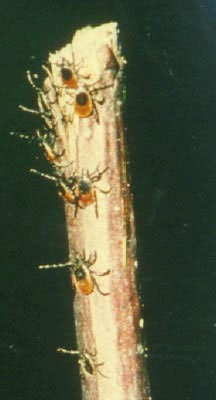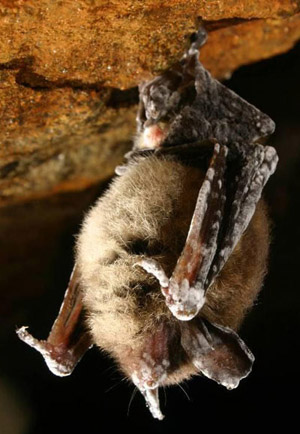- Home
- About S&T
- Taxa/Organisms
- Ecosystems
- Issues
- Methods & Tools
- Reports & Publications
- Location
- Search
Publisher: USGS | Science Center: Patuxent Wildlife Research Center (PWRC, Laurel) | Format: URL
www.pwrc.usgs.gov — Dr. Howard Ginsberg is studying the transmission of Lyme disease spirochetes in nature using ecological studies of ticks and their vertebrate hosts, and models of spirochete transmission dynamics. Environmental factors that influence tick populations apparently operate on a regional scale. Distribution of vertebrate hosts plays a role in tick More...

2007 | Publisher: Other (Ecological Society of America) | Format: .PDF
www.nrmsc.usgs.gov — Every winter, government agencies feed ;6000 metric tons (63 106 kg) of hay to elk in the southern Greater Yellowstone Ecosystem (GYE) to limit transmission of Brucella abortus, the causative agent of brucellosis, from elk to cattle. Supplemental feeding, however, is likely to increase the transmission of brucellosis in elk, and may be affected by More...

Publisher: USGS | Format: URL
www.usgs.gov — It has been estimated that over 100,000 bats have died in the northeast due to a mysterious white fungus called White-Nose Syndrome (WNS). Scientists are finding within caves and mines a large number of bats with a white fungus on their muzzles and other parts of their bodies. It is uncertain as to how this fungus is being transmitted and its More...

Publisher: Other Federal Agency (United States Fish and Wildlife Service (USFWS)) | Format: URL
www.fws.gov — Tens of thousands of hibernating bats died this winter in the northeast, and for unknown reasons. In and around caves and mines in eastern and upstate New York, Vermont, western Massachusetts, and northwestern Connecticut, biologists found sick, dying and dead bats in unprecedented numbers. In just eight of the affected New York caves, mortality More...

Publisher: USGS | Science Center: Fort Collins Science Center (FORT, Ft. Collins) | Format: URL
www.fort.usgs.gov — The dynamics of rabies transmission in bat populations that roost and live within cities is being investigated using Fort Collins, Colo., and big brown bats (Eptesicus fuscus) as the case study. USGS biologists are working on this project in collaboration with Colorado State University, the Centers for Disease Control and Prevention, and the More...

Publisher: USGS | Science Center: Fort Collins Science Center (FORT, Ft. Collins) | Format: URL
www.fort.usgs.gov — During the winter of 2006 or 2007, an affliction of unknown origin dubbed "White-Nose Syndrome" (WNS) began devastating colonies of hibernating bats in a small area around Albany, New York. Colonies of hibernating bats were reduced 81-97 percent at the affected caves and mines that were surveyed. Since then, White-Nose Syndrome has been detected More...

Publisher: USGS | Science Center: National Wildlife Health Center (NWHC, Madison) | Format: URL
www.nwhc.usgs.gov — Learn about the West Nile Virus (WNV) from this USGS National Wildlife Health Center's Web page. Contains links to fact sheets and information from other government agencies and organizations.

Publisher: USGS | Science Center: National Wildlife Health Center (NWHC, Madison) | Format: URL
www.nwhc.usgs.gov — The ongoing pandemic of Foot-and-Mouth Disease (FMD) in Europe and other parts of the world is of great concern to the North American Agriculture Community. FMD may also pose a significant threat to North American wildlife, including white-tailed deer, other deer species, feral pigs, bison, moose, antelope, peccaries, musk ox, caribou, sheep and More...

Publisher: USGS | Science Center: National Wildlife Health Center (NWHC, Madison) | Format: URL
www.nwhc.usgs.gov — Chronic wasting disease (CWD) is a disease of the nervous system in deer and elk that results in distinctive brain lesions. It continues to be a major issue for wildlife scientists throughout the Nation, and a key focus for research at the USGS National Wildlife Health Center (NWHC). Research is focused on understanding how the disease is More...

Publisher: USGS | Science Center: Forest and Rangeland Ecosystem Science Center (FRESC, Corvallis) | Format: URL
fresc.usgs.gov — Biologists and managers on Washington's Olympic Peninsula, as throughout western Washington, are concerned about increased observations over the last several years of emaciated deer with symptoms of excessive hair-loss. This Web page describes a study to evaluate modern pellet-group survey methods, estimate abundance of deer and elk, identify More...

Publisher: USGS | Science Center: Fort Collins Science Center (FORT, Ft. Collins) | Format: URL
www.fort.usgs.gov — As one of one of the big three charismatic predators in North America, mountain lions top the list of national park management challenges that require balancing the preservation of species with protection of park visitors. In Rocky Mountain National Park and its environs, USGS Fort Collins Science Center (FORT) scientists are collaborating with More...

Publisher: USGS | Science Center: National Wildlife Health Center (NWHC, Madison) | Format: URL
www.nwhc.usgs.gov — The condition in bats known as "white-nose syndrome" (WNS) was first noted among dead and hibernating bats found in caves near Albany, New York, by the New York State Department of Environmental Conservation beginning in February 2007. Affected bats appeared to have a white substance on their heads and wings. In early 2008, "white-nosed" bats were More...
